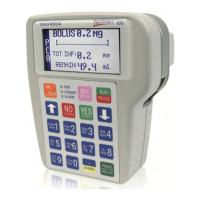43
Customized Lock Level setting
A customized Moog Curlin Infusion PainSmart
™ IOD pump may have a certain Lock Level value
set in the factory which is not the default OFF. It can be any one of these values: Lock Level 1, Lock
Level 2, or Lock Level 3.
The pump user is not allowed to change the customized factory programmed Lock Level
setting. If you attempt to change the customized Lock Level, the pump will display an alert,
“MODIFICATIONS NOT ALLOWED.”
LED Light Indicators
This three-light feature gives the user feed back on the current status of the pump.
1. Green indicates a Running status of the pump and blinks approximately once every three
seconds when a therapy is in progress.
2. Yellow indicates a Standby status of the pump and blinks while the pump is paused.
3. Red indicates a Stopped or Alarm status of the pump and blinks whenever an alarm status
exists.
4. Green and Red indicates an Infusion Complete Alarm status with KVO or a Down
Occlusion Alarm with automatic restart.
5. Yellow and Green indicates a Standby status with automatic start. This occurs when a “0”
basal rate and bolus only is programmed.
Audio Indicator
An audible alarm or “beep” is used to alert you to a change in the status of the pump or a situation
requiring user action or notification. A message will appear on the display screen describing the
situation. The rate, number of beeps, and volume further specify status. This pump offers nine
different volume levels from which to select for the audio feature; however, the beep cannot be
totally disabled. The audio beep can be silenced for one-minute intervals by pressing the SILENCE
key except during an Error Code, at which time the alarm continues and the pump must be turned
off. The chapter of this manual, entitled “Troubleshooting,” includes tables with the alerts, alarms,
error codes, the conditions causing them, the message displayed on the screen, and the actions
required for resolution. If an alert or alarm occurs, please refer to these tables.

